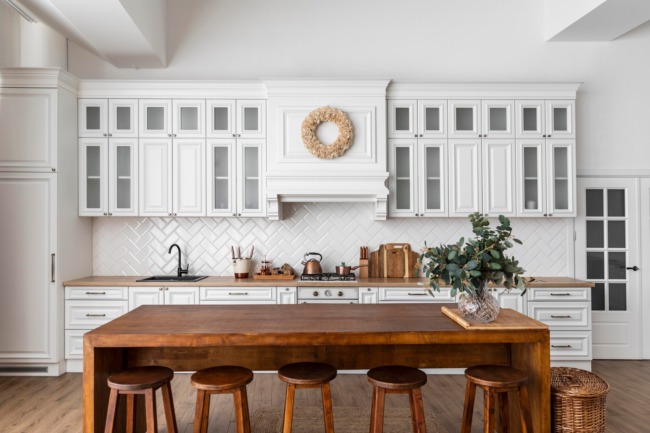
Overwhelmed by the choices for kitchen cabinet finishes? It’s a common feeling! Your decision on cabinet finishing can significantly impact – even make or break – your kitchen’s overall look, feel, and longevity. From classic painted and rich glazed options to durable laminate and natural stained wood, each finish type offers unique benefits and drawbacks that cater to different lifestyle needs, aesthetic preferences, and budgets. Whether you’re embarking on a complete overhaul with a kitchen remodeling service or simply refreshing your existing cabinets, understanding the nuances of each option will empower you to select the perfect finish that beautifully balances style with the practical durability your kitchen demands.
Understanding Cabinet Finishes: More Than Just Color
The world of cabinet finishes offers a diverse palette, each bringing unique characteristics and performance levels to your kitchen space. It’s not just about the surface color; the finish interacts with the underlying cabinet material (be it solid wood, MDF, plywood, or particleboard) and the construction quality. From versatile painted and artisanal glazed finishes to practical laminates and timeless stains, your choice will profoundly impact both the aesthetic appeal and the long-term resilience of your cabinets. According to industry data, well-constructed cabinets with appropriate, quality finishes can last 20-30 years, sometimes even longer, when properly maintained, making this decision a significant investment in your home’s functionality and future value.

The Crucial Importance of Cabinet Finishes
By choosing the right finish, you’re doing far more than selecting a look – you’re investing in your kitchen’s durability, ease of maintenance, and overall value. Quality finishes act as a protective shield for your cabinets, guarding them against the rigors of daily use, including spills, splashes, moisture, heat fluctuations, grease, fingerprints, and minor impacts. A good finish makes cleaning easier and enhances the cabinet’s appearance, maintaining its beauty for years. Furthermore, studies consistently show that kitchen renovations featuring quality cabinetry and appealing finishes can recover a substantial portion of their cost – sometimes up to 70% or more – when you eventually sell your home.
Lifestyle Considerations: Matching Finishes to Your Life
When evaluating cabinet finishes, it’s crucial to honestly assess your household’s specific needs and daily habits. If you have young children or pets, a highly durable, scratch-resistant, and easily wipeable finish like laminate or a quality catalyzed paint might be your best bet. For the aspiring home chef who spends hours cooking, a finish resistant to heat, stains, and moisture is paramount. If your kitchen is a high-traffic hub for entertaining, you might desire a show-stopping look like high-gloss acrylic or a deep, luxurious stain, but be prepared for potentially more frequent cleaning. Consider your cooking frequency, cleaning tolerance, the amount of direct sunlight exposure (which can affect some finishes), and general kitchen activity levels. These factors should heavily influence your decision. Statistics indicate that households with children often prioritize durability, with a significant majority (around 65%) choosing robust laminate or durable paint options. Busy professionals might lean towards low-maintenance choices.
Painted Finishes: A World of Color
It’s worth noting that painted finishes offer unparalleled design flexibility, transforming your kitchen with nearly endless color possibilities and various sheen levels to perfectly match your design vision. You can choose from high-gloss for a sleek, modern look, semi-gloss or satin for a balance of durability and subtle shine (very popular choices), or matte for a sophisticated, contemporary feel. Painted cabinets provide a clean, smooth, and uniform appearance, ideal for achieving specific color schemes from bright and airy to bold and dramatic. While they offer excellent design versatility, keep in mind that painted finishes, especially on edges and high-touch areas, can be more prone to chipping or showing wear over time compared to stains. You’ll likely need to plan for occasional touch-ups to maintain their pristine appearance, but the vast customization potential makes them a favorite for many homeowners seeking a personalized kitchen. Proper surface preparation and professional application are key to a lasting painted finish.

Glazed Finishes: Adding Depth and Character
One of the most sophisticated and artisanal options you can choose for your kitchen cabinets is a glazed finish. Typically applied by hand over a base coat of paint or stain, the glaze settles into the cabinet’s profiles, corners, and details (like carvings or recessed panels), highlighting the underlying color and adding a layer of depth, dimension, and often, an antiqued or subtly aged appearance. This technique is excellent for achieving that coveted vintage, rustic, or traditional aesthetic that can elevate your interior design. Glazing enhances the cabinet’s visual texture. However, you should consider that the crevices highlighted by the glaze can require more diligent cleaning, as they may tend to accumulate dust and grime more readily than smoother finishes. With proper maintenance, though, your glazed cabinets can become a stunning, character-rich focal point in your kitchen.
Laminate Finishes: Durability Meets Design
For busy family kitchens or high-use areas, you’ll find laminate finishes to be an excellent, practical choice. Your cabinets will benefit from this highly durable, factory-applied material that strongly resists scratches, stains, heat, and moisture, making it perfect for the demands of daily life. Modern laminates come in a vast array of solid colors, realistic wood grains, patterns, and even textures (like High-Pressure Laminate – HPL, known for its superior toughness, often used on countertops but also cabinets, versus Low-Pressure Laminate – LPL or Melamine, common for cabinet boxes and doors). You’ll appreciate how easy laminate surfaces are to clean and maintain, usually requiring just a simple wipe-down. While you should be aware that edges, if not properly banded, can be susceptible to chipping, and some may feel laminate lacks the authentic depth of real wood, the overall durability, consistency, and cost-effectiveness make it a smart, reliable choice for many active households.
Stained Finishes: Celebrating Natural Wood
Clearly, if you cherish the inherent beauty of wood and want to showcase its natural grain, texture, and warmth while ensuring lasting durability, stained finishes offer an excellent solution. Stains penetrate the wood fibers, enhancing the grain rather than covering it like paint. You can choose from a wide spectrum of shades, from light, natural tones that brighten the space to deep, rich hues that add sophistication. After staining, cabinets are typically protected with a clear topcoat (like lacquer, varnish, or polyurethane) in various gloss levels (matte, satin, semi-gloss, gloss) to provide resistance against moisture and wear. Many homeowners appreciate that stained finishes tend to hide minor scratches and dings more effectively than paint. While the color palette is dictated by the wood species and stain combinations (offering fewer distinct color options compared to paint), stained finishes deliver an authentic, timeless wood appearance that significantly enhances a kitchen’s warmth and character. Quality cabinet makers, such as those potentially offered by suppliers like Guilin Cabinets, often excel at providing beautifully stained wood options.
Acrylic Finishes: Sleek and Contemporary
After exploring acrylic finishes, you’ll find they offer a distinctive, ultra-modern, high-gloss look for your kitchen cabinets. Often applied over an MDF core, acrylic provides a flawless, reflective, almost mirror-like surface that’s highly resistant to scratches and UV light, meaning the vibrant color won’t fade over time. Available in a wide range of bold, contemporary solid colors, this finish creates a sleek, seamless, and luxurious aesthetic, perfect for modern and minimalist kitchen designs. The reflective quality can also help make smaller kitchens feel larger and brighter. While the smooth, high-gloss surface adds a definite touch of luxury, its main drawback is that it readily shows fingerprints, smudges, and water spots, requiring frequent wiping with a soft microfiber cloth to maintain its pristine appearance. This finish is particularly suitable if your design goal is a cutting-edge, contemporary kitchen.

Basic Maintenance Tips for Cabinet Finishes
- General Cleaning: For most finishes (paint, stain, laminate, acrylic), use a soft, damp cloth (microfiber is ideal) with mild soap and water for routine cleaning. Avoid abrasive cleaners or scouring pads. Dry surfaces promptly.
- Grease Removal: Use a cleaner specifically designed for grease on kitchen surfaces if needed, testing in an inconspicuous area first.
- Glazed Cabinets: Use a soft brush (like a toothbrush) to gently clean dust from crevices.
- Touch-Ups: Keep touch-up paint or stain provided by the manufacturer handy for minor nicks on painted or stained cabinets.
- Avoid Harsh Chemicals: Bleach, ammonia, and solvents can damage most finishes.
Summing Up: Finding Your Perfect Match
To wrap up, your choice of kitchen cabinet finish is a critical decision that should thoughtfully align with your lifestyle, design preferences, maintenance tolerance, and budget. You’ll find that painted finishes offer unmatched color versatility but may require touch-ups over time. Laminate provides excellent durability and ease of care, ideal for busy households. If you’re seeking to highlight natural wood beauty, stained finishes are a classic and forgiving choice. For a bold, modern statement, acrylic delivers a sleek, high-gloss appearance, though it demands regular cleaning. Varnished or natural oil finishes (not detailed above but also options) offer other ways to protect and enhance wood with varying looks and maintenance needs. By carefully considering the pros and cons of each option in the context of your specific needs and perhaps consulting with design professionals or your chosen kitchen remodeling service, you’ll be well-equipped to select a finish that not only enhances your kitchen’s aesthetics but also performs reliably for years to come.
